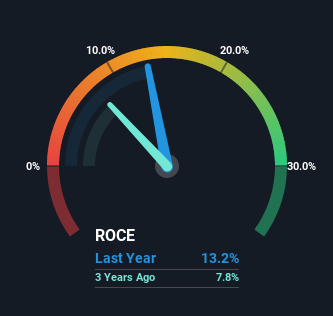- United Kingdom
- /
- Media
- /
- LSE:BMY
Investors Will Want Bloomsbury Publishing's (LON:BMY) Growth In ROCE To Persist

What trends should we look for it we want to identify stocks that can multiply in value over the long term? Ideally, a business will show two trends; firstly a growing return on capital employed (ROCE) and secondly, an increasing amount of capital employed. Ultimately, this demonstrates that it's a business that is reinvesting profits at increasing rates of return. So when we looked at Bloomsbury Publishing (LON:BMY) and its trend of ROCE, we really liked what we saw.
Understanding Return On Capital Employed (ROCE)
Just to clarify if you're unsure, ROCE is a metric for evaluating how much pre-tax income (in percentage terms) a company earns on the capital invested in its business. To calculate this metric for Bloomsbury Publishing, this is the formula:
Return on Capital Employed = Earnings Before Interest and Tax (EBIT) ÷ (Total Assets - Current Liabilities)
0.13 = UK£26m ÷ (UK£313m - UK£117m) (Based on the trailing twelve months to August 2022).
Therefore, Bloomsbury Publishing has an ROCE of 13%. That's a relatively normal return on capital, and it's around the 12% generated by the Media industry.
Check out the opportunities and risks within the GB Media industry.

Above you can see how the current ROCE for Bloomsbury Publishing compares to its prior returns on capital, but there's only so much you can tell from the past. If you'd like to see what analysts are forecasting going forward, you should check out our free report for Bloomsbury Publishing.
What Can We Tell From Bloomsbury Publishing's ROCE Trend?
The trends we've noticed at Bloomsbury Publishing are quite reassuring. Over the last five years, returns on capital employed have risen substantially to 13%. The amount of capital employed has increased too, by 37%. The increasing returns on a growing amount of capital is common amongst multi-baggers and that's why we're impressed.
On a side note, we noticed that the improvement in ROCE appears to be partly fueled by an increase in current liabilities. The current liabilities has increased to 37% of total assets, so the business is now more funded by the likes of its suppliers or short-term creditors. Keep an eye out for future increases because when the ratio of current liabilities to total assets gets particularly high, this can introduce some new risks for the business.
The Key Takeaway
To sum it up, Bloomsbury Publishing has proven it can reinvest in the business and generate higher returns on that capital employed, which is terrific. And a remarkable 214% total return over the last five years tells us that investors are expecting more good things to come in the future. In light of that, we think it's worth looking further into this stock because if Bloomsbury Publishing can keep these trends up, it could have a bright future ahead.
Bloomsbury Publishing does have some risks though, and we've spotted 1 warning sign for Bloomsbury Publishing that you might be interested in.
If you want to search for solid companies with great earnings, check out this free list of companies with good balance sheets and impressive returns on equity.
Valuation is complex, but we're here to simplify it.
Discover if Bloomsbury Publishing might be undervalued or overvalued with our detailed analysis, featuring fair value estimates, potential risks, dividends, insider trades, and its financial condition.
Access Free AnalysisHave feedback on this article? Concerned about the content? Get in touch with us directly. Alternatively, email editorial-team (at) simplywallst.com.
This article by Simply Wall St is general in nature. We provide commentary based on historical data and analyst forecasts only using an unbiased methodology and our articles are not intended to be financial advice. It does not constitute a recommendation to buy or sell any stock, and does not take account of your objectives, or your financial situation. We aim to bring you long-term focused analysis driven by fundamental data. Note that our analysis may not factor in the latest price-sensitive company announcements or qualitative material. Simply Wall St has no position in any stocks mentioned.
About LSE:BMY
Bloomsbury Publishing
Bloomsbury Publishing Plc publishes academic, educational, and general fiction and non-fiction books for children, general reader, teachers, students, researchers, libraries, and professionals worldwide.
Excellent balance sheet average dividend payer.
Similar Companies
Market Insights
Community Narratives



